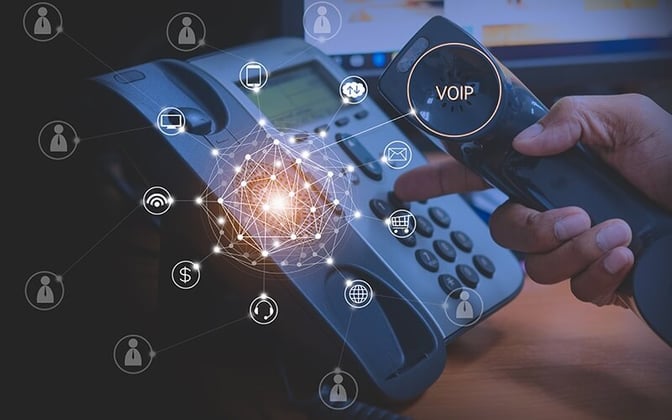Originally Published August 2018
Updated November 2024
Upgrading doesn’t have to mean buying new.
We’ve worked with many organizations to improve their office phone systems. Many are told that buying new is the best way to upgrade, and that's not always true.
In fact, migrating your existing phone system onto the latest or a similar platform could save you money. Stick with me.
Do You Have an Outdated Phone System?
Upgrading a phone system is an important decision for any business to account for new features and end-user inefficiencies. Often, businesses are forced to upgrade because of aging phone systems or systems that have reached the end of life.
If you’re looking at upgrading your business phone system for any of these reasons, I encourage you to consider migration as an option. Here are some helpful points to consider:
End of Life Deadlines Forced Phone System Changes for Many Organizations
The ShoreTel Connect (now Mitel) and all NEC systems are set to reach their end of life, with the beginning stages at the end of 2024. This means that starting January 1st, 2025, it will no longer be possible to purchase new equipment for these systems. It's important to note that while NEC has exited the market for every model, support will continue until the latest possible date of March 31st, 2030, though the last date to purchase the support will be December 31st, 2025. On the other hand, Mitel will provide support for their systems through December 31st of 2029 and may be purchased up until that time.
Given these changes, our clients are proactively choosing to migrate to cloud-based solutions. These modern solutions offer enhanced functionality and ensure continued support and updates, making them a reliable choice for the future.
When a Phone System Reaches End of Life, Support Becomes Best Effort
To be clear, a phone system will not just stop working when it reaches end of life. Partners, like Loffler, can support these systems to the best of our ability, but we don’t get support from the manufacturer. We’ll work on it as much as we possibly can, but end of life often means we don’t have access to upgrades, updates or fixes.
When there is an issue with system hardware or software, for example an integration with Microsoft, there’s little to nothing we can do. As time goes on, parts will be harder to come by.
Putting off Phone System Migration Could Cause Cost Increases
Think of software assurance as your car or health insurance; if something happens, you are glad you have it! When a system reaches end of life, the manufacturer does not allow for purchase of software assurance.
If you stay current and have your software assurance, manufacturers often provide price breaks during migrations and upgrades. They also typically allow you to transfer your current licensing to the new platform. Without this safety net, you are basically repurchasing a system you have already purchased.
Older Phone Systems Had a Lifespan of About Eight Years – That’s No Longer the Case
The lifespan of phone systems today is hard to pin down because of migrations and upgrades. This prevents you from having to buy a new system every five to eight years. Newer phone systems are more software-based, which keeps you up to date with technology, features and functionality, such as contact center technology.
As long as you keep your hardware up to date (i.e. servers), you can use the actual phones until they get old or go bad. This provides a cost-effective way to stay current with updates – like adding instant messaging or a Unified Communication (UC) platform on your desktop – while simplifying use and management of your existing phone system.
The Phones Themselves Are the Most Expensive Component
Why invest in new phones if your current ones are still working? When upgrading your current phone system, buying a new one is always an option, but you may want to consider the cost savings found in migrating.
Reusing your existing phones helps save and protect your initial investment. More manufacturers are allowing you to use SIP (Session Initiation Protocol) standard phones on their software-based platforms, giving you the flexibility to use different handsets on multiple platforms.
Migrating Your Phone System Offers a Cost-Effective Alternative
A phone system migration will cost around one-third the amount of buying a whole new phone system. Labor and migration kit costs need to be considered, but when compared to buying a whole new phone system, including the hardware involved with new phones, a lower-cost migration is pretty appealing.
Migrations are commonly scheduled during off hours so you experience little to no downtime. The preparation work is done during the business day with the migration happening overnight. Read more about other cost considerations when considering new business phone systems.
So, how do you know if you need a new phone system or a new platform? Explore all your options (is Unified Communications right for you? Should you be in the cloud, or on premise? And you're considering a cloud-based phone system, what benefits will you see?), plan ahead and lean on the experts for knowledge.
LEARN MORE ABOUT LOFFLER'S PHONE SYSTEM OPTIONS
Read Next: Unified Communications: All Your Communications Tools in One Fully-Unified Platform

John Murphy is the Solutions Architect of Unified Communications at Loffler, and has been part of the Loffler team since 2005. He has an extensive background in communication and collaboration software, with experience spanning the areas of premise phone systems, Unified Communications, Contact Center, phone lines, and WAN circuits. He is a big Vikings fan and loves spending time doing activities outdoors - ATV, snowmobiling, hiking, and regularly attempting to improve his golf game.



